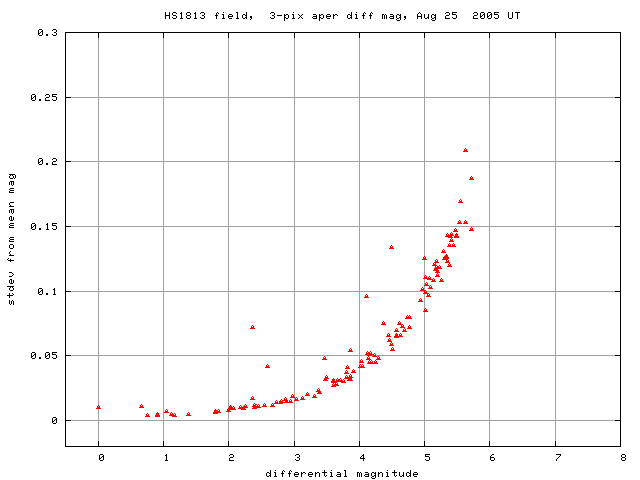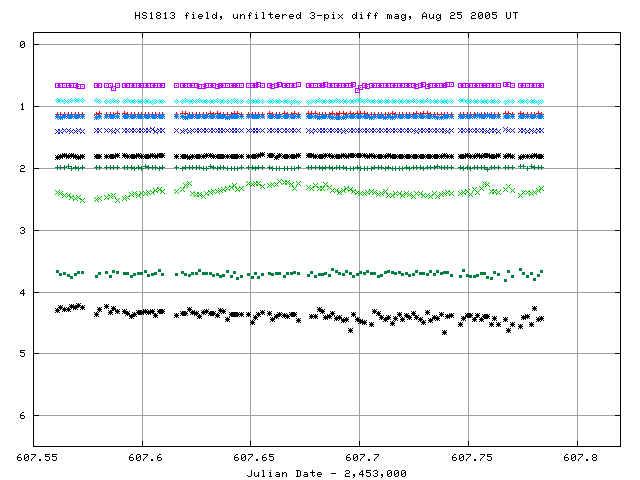
On the night of Aug 24/25, 2005 EDT, George Privon and I used the RIT Observatory's 12-inch Meade telescope and SBIG ST8 CCD camera to monitor the cataclysmic variable stars HS 1813+61. It is a target of the Center for Backyard Astrophysics; see Jochen Pietz' analysis of earlier observations of HS 1813+61 for more details about it.
The plan:
Notes from the night
This is a chart of the field based on images taken on earlier nights. Click on the chart for a larger version.
The best photometry I could find for the stars in this field is simply the USNO B1.0 -- oh, well. The star marked "B" in the chart above is USNO B1.0 1514-0236071. Based on the USNO B1.0 "B" and "R" magnitudes, I calculate a very very rough "V" magnitude via the simple average "V" = (B+R)/2 = 13.77. I'll use that to set the zeropoint of the differential unfiltered measurements; not good, but all I can do for now. I hope someone does good photometry of field stars on the standard scale ...
The star marked "X" on the chart above is USNO-B1.0 1514-0236034. It showed strongs hints of variability during other nights. Tonight, it was relatively constant over the run, but significantly fainter than the star "Y".
I measured the instrumental magnitude of each star with aperture photometry, using a radius of 3 pixels = 5.6 arcseconds and sky defined by an annulus around each star. Following the procedures outlined by Kent Honeycutt's article on inhomogeneous ensemble photometry, I used all stars available in each image to define a reference frame, and measured each star against this frame.
Below is a graph of the scatter in differential magnitude versus magnitude.

HS 1813+61 is the star near differential mag 2.3, with an elevated scatter. The other outliers in this diagram are caused by isolated bright points due to cosmic rays.
Light curves for selected stars in the field are shown below. HS 1813+61, shown by light green crosses near the middle, seems a bit more wobbly than other stars. The black points near the bottom are star "X", while the small green squares near the bottom are star "Y".

Here's a closeup of the variation in HS 1813+61 itself. I examined the images carefully around the time of the brief "flare" (JD approx 607.62), and can find no sort of image defect near the position of the variable. The same goes for the bright points near JD 607.76: the images show no defect which might cause HS1813+61 to vary while the surrounding stars remain constant.

I've made a table of the measurements themselves, with three different flavors of time. The differential unfiltered magnitudes from the ensemble solution has been shifted so that star "B" in my chart, has value 13.77, matching a very rough guess at its V-band magnitude, based on B and R mags in the USNO B1.0 catalog.
Here's the start of the table.
# Measurements of HS 1813+61 made at RIT Obs, Aug 25, 2005 UT, # made by Michael Richmond and George Privon. # All data taken with 12-inch LX-200 + no filter + SBIG ST-8 CCD # no focal reducer, so at native f/10 # Each exposure 120 seconds long; tabulated times are midexposure # and accurate only to +/- 1 second. # 'mag' is a differential magnitude based on ensemble photometry # which has been shifted so USNOB1.0 1514-0236071 has mag=13.77 # (a rough guess = (B+R)/2 and the USNO B1.0 magnitudes). # # UT day JD-2,450,000 HJD-2,450,000 mag uncert Aug25.06096 3607.56096 3607.56136 15.002 0.013 Aug25.06253 3607.56253 3607.56293 15.010 0.014 Aug25.06412 3607.56412 3607.56452 15.043 0.016
Last modified 8/25/2005 by MWR.